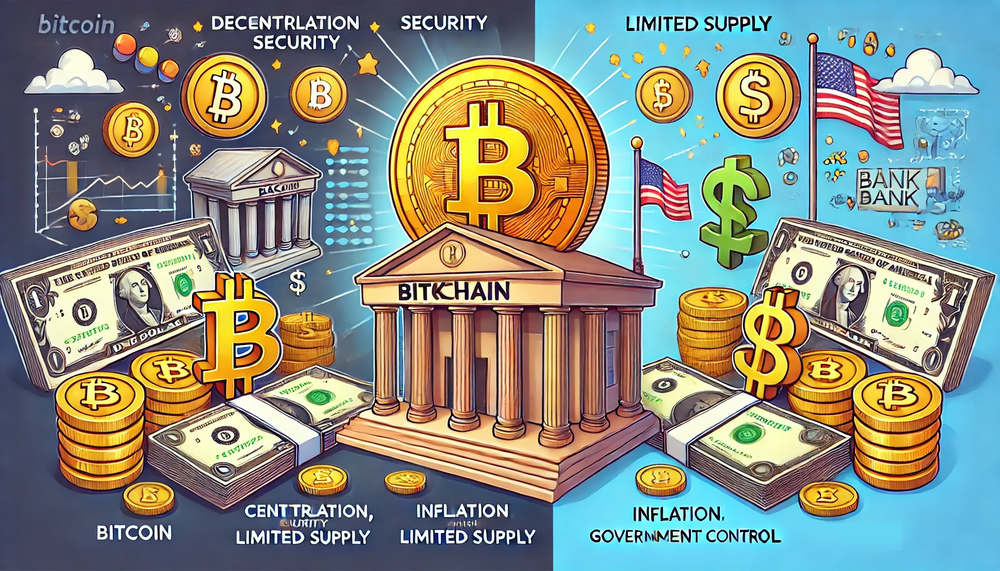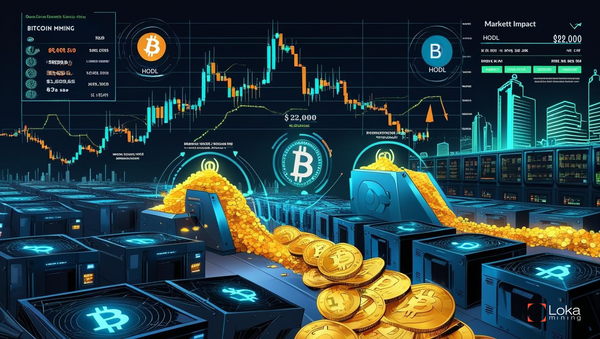Bitcoin vs. Fiat: Understanding the Differences

The world of money has evolved significantly over centuries, bringing forth two distinct forms of currency today—Bitcoin and fiat. Though they serve as mediums of exchange, Bitcoin and fiat differ fundamentally in their characteristics, principles, and operations. Here’s a comprehensive overview of what sets them apart.
1. Basic Definitions
- Bitcoin: Created in 2009 by an anonymous entity known as Satoshi Nakamoto, Bitcoin is a decentralized digital currency powered by blockchain technology. It was designed as an alternative to traditional financial systems, emphasizing decentralization, transparency, and privacy.
- Fiat: Fiat refers to government-issued currencies such as the US Dollar (USD), Euro (EUR), or Indonesian Rupiah (IDR). Unlike commodity-backed money, fiat currency derives its value from the trust and confidence people place in the issuing government. It has no intrinsic value on its own.
2. Centralization vs. Decentralization
- Bitcoin operates on a decentralized network, meaning no single authority, like a bank or government, controls it. Transactions are verified and processed by a network of computers (nodes) using a consensus mechanism known as Proof of Work (PoW). This decentralization makes Bitcoin resistant to censorship and manipulation by third parties.
- Fiat currencies are entirely centralized and managed by the governments and central banks that issue them. These entities control money supply, interest rates, and monetary policy, allowing for interventions such as currency devaluation or quantitative easing, which may lead to inflation or instability.
3. Supply and Creation
- Bitcoin: Bitcoin’s supply is capped at 21 million coins, as determined by its protocol. This limited supply creates a deflationary effect over time, especially as halving events periodically reduce the mining rewards given to miners every four years.
- Fiat: The supply of fiat money is not fixed. Central banks can print or reduce the money supply according to their monetary policies. Practices like quantitative easing can lead to inflation as the supply of money grows without a corresponding increase in goods and services.
4. Form and Storage
- Bitcoin: Bitcoin is entirely digital and can be stored in various wallets, including hardware wallets, software wallets, or cold storage. Transactions occur using unique cryptographic addresses, and each transaction is permanently recorded on the blockchain ledger.
- Fiat: Fiat can exist in physical form (bills and coins) or digital form, stored in bank accounts. Transactions are carried out through banks, credit cards, and digital payment systems. Unlike Bitcoin, fiat relies on trusted third parties such as banks to process and verify transactions.
5. Transparency and Security
- Bitcoin transactions are recorded on a public blockchain, allowing anyone to verify and access the transaction history. While transactions are pseudonymous, they are transparent and immutable, secured by cryptographic algorithms and decentralized consensus.
- Fiat transactions are private and accessible only by authorized parties like banks or financial institutions. While this privacy can provide security, it can also lead to less auditability and susceptibility to fraud, corruption, or mismanagement.
6. Transaction Speed and Cost
- Bitcoin: Bitcoin can provide fast international transactions compared to traditional banks. However, network congestion can increase transaction times and fees. Solutions like Layer 2 technologies (e.g., Lightning Network) aim to enhance transaction speed and lower costs.
- Fiat: Transaction speed and cost vary widely for fiat. Domestic transfers may be quick, but international transfers can take days and involve high fees, due to the involvement of multiple intermediaries like banks and payment processors.
7. Intrinsic Value
- Bitcoin: Some argue that Bitcoin has intrinsic value derived from its scarcity, decentralized nature, and utility in transferring value across borders without intermediaries. It is often compared to "digital gold" due to its limited supply and store-of-value properties.
- Fiat: Fiat has no intrinsic value; it derives its worth solely from public trust in the issuing government. If confidence in a government erodes, the value of its fiat currency can quickly decline.
8. Economic and Social Implications
- Bitcoin offers a decentralized, borderless financial system accessible to anyone with an internet connection, potentially benefiting individuals in underbanked regions. It grants individuals greater control over their money without requiring third-party authorization.
- Fiat remains the primary currency for the global economy and supports complex economic policies and regulations. However, its centralized nature may lead to inflation, mismanagement, or authoritarian control in certain regions.
Key Advantages of Bitcoin
- Decentralization: No single authority controls the network, reducing the risk of censorship.
- Fixed Supply: Capped at 21 million coins, limiting inflationary risks.
- Transparency: Transactions are traceable on a public ledger.
- Global Accessibility: Borderless and can be accessed anywhere with internet connectivity.
Key Advantages of Fiat
- Stability: Generally accepted and used globally, providing economic stability.
- Flexibility: Central banks can implement monetary policies to stabilize economies during crises.
- Wide Acceptance: Fiat is recognized as legal tender for goods and services.
Conclusion
While Bitcoin and fiat both serve as currencies, they represent contrasting ideologies and functions. Bitcoin focuses on decentralization, scarcity, and privacy, while fiat relies on central authority and public trust. Choosing between the two depends on individual preferences, needs, and trust in centralized systems versus decentralized alternatives.
This article presented by Loka Mining.
Loka is revolutionizing the Bitcoin mining ecosystem by directly connecting investors with Bitcoin miners through a decentralized mining pool and an upcoming permissionless forward hashrate marketplace protocol.
Loka enables investors to get Bitcoin at lower than market price without centralized & counter-party risks, and Bitcoin miners to access capital efficient financing and hedge their risk exposure by selling their future mining rewards.
Find out more about loka in https://lokamining.com — or access our mining pool aggregator on https://pool.lokamining.com





